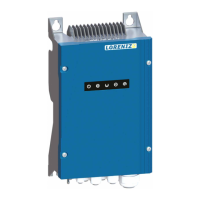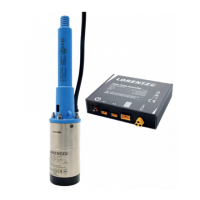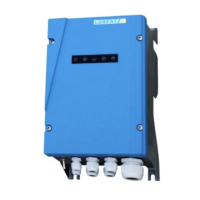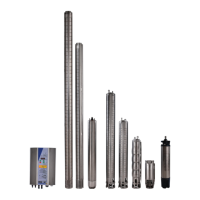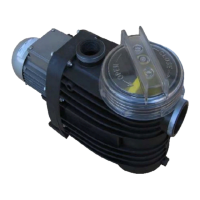11
4.2 Grounding and Lightning Protection
Surges induced by lightning are one of the most com-
mon causes of electronic controller failures in solar
water pumps. Damaging surges can be induced from
lightning that strikes a long distance from the system,
or even between clouds. The risk of damage is greatly
reduced if these instructions are followed.
Location of the pump controller Place the
controller close to the solar array, not the pump. This
will reduce the risk of lightning damage. Explanation:
The controller’s input circuitry is more sensitive to surges
than its output. It is safest to minimize the length of the
input wiring.
Construct a discharge path to ground A properly
made discharge path to ground (earth) will discharge
static electricity that accumulates in the above-ground
structure. This helps prevent the attraction of lightning.
If a lightning strike occurs at close proximity, a well-
grounded conductive structure can divert the surge
AROUND the electrical circuitry, greatly reducing the
potential for damage. The controller has built-in surge
protectors, but they help ONLY if the system is effectively
grounded.
Earth connection – create an effective discharge
path It helps to picture this as a “drain field” for
electrons. Here are suggestions for grounding, in order
of their efficacy:
1. The best possible ground rod is a steel well
casing located near the array. Drill and tap a
hole to make a strong bolted connection to the
casing with good metallic contact. Bolt on a brass
terminal lug. After the connection is made, seal
the connection with silicone sealant or other wa-
terproof compound to prevent corrosion. Protect
the ground wire(s) from physical damage so they
aren’t stressed by being stepped on, etc.
2. Install a copper plate or other specialized ground-
ing devices designed for the purpose. Some
systems use salts to improve the conductivity of
the surrounding soil.
3. Install one or more copper-plated ground rods at
least 8 ft (2.5 m) long, preferably in moist earth.
Where the ground gets very dry (poorly conduc-
tive), install more than one rod, spaced at least
10 ft (3 m) apart.
4. If the soil is rocky and does not allow ground rods
to be driven, bury BARE copper wire in a trench
at least 100 ft (30 m) long. If a trench is to be
dug for burial of water pipes, ground wire can
be run along the bottom of the trench. The wire
size must be minimum #6 (16 mm
2
) or double #8
(10 mm
2
). Connect one end to the array structure
and controller. Or, cut the ground wire shorter and
spread it in more than one direction.
Dry or rocky locations To achieve good grounding
at a dry or rocky site, consult a local contractor who
specializes in lightning protection. It is best to plan the
procedure in advance, and to coordinate the effort with
other earth-excavating procedures that need to be done.
Reference: www.lightning.org
Bond (interconnect) all the metal structural com-
ponents and electrical enclosures Interconnect the
PV module (solar panel) frames, the mounting rack, and
the ground terminals of the disconnect switch and the
controller, using wire of minimum size #8 (6 mm
2
), and
run the wire to an earth connection.
Ground connections at the controller The control-
ler and junction box have redundant ground terminals
inside. They are all connected in common with the metal
enclosures of both the controller and the junction box.
Ground connections can be made to any of these points.
Ground connections to aluminum This ap-
plies to connections at the solar array framework,
and at the controller’s enclosure box. Connections to
aluminum must be made using terminal lugs that have
an aluminum-tocopper rating (labeled “AL/CU”) and
stainless steel fasteners. This will reduce the potential
for corrosion.
WARNINGFailure to install and
connect an effective grounding
system will greatly increase the
risk of lightning damage and will
void your warranty. We suggest
you wire the grounding system
FIRST so it is not overlooked. The
concrete footer of a groundmount-
ed array will NOT provide
adequate electrical grounding.
DO NOT GROUND the positive or the negative
of the power circuit. The best lightning protection
results from grounding the metallic structure only, and
leaving the power system ungrounded. This is called a
“floating” system.
Explanation: With a floating system and a good struc-
tural ground, lightning induced surges tend to reach
ground through the structure, instead of the power cir-
cuit. When high voltage is induced in the power circuit,
the voltage in negative and the positive sides tend to be
nearly equal, thus the voltage BETWEEN the two is not
so high, and not usually destructive. This method has
been favored for many decades by most engineers in the
remote power and telecommunications fields.
Exception for battery systems: You can connect the
pump to a battery-based home power system that has a
negative ground. If the wiring distance to the pump ex-
ceeds 100 ft (30 m), particularly in a high lightning area,
DC-rated surge protection devices are recommended.
Legal exception: If the local electrical authority
requires grounding of the power circuit, ground the PV
ARRAY NEGATIVE wire. This may increase the risk of
lightning damage.
Solar array wiring Bind the array wires close
together, or use multi-wire cable. Avoid forming loops.
This helps induced voltages in each side of the circuit to
equalize and cancel each other out.
Wire twisting for long runs Twisting wires together
tends to equalize the voltage induced by lightning. It
reduces the voltage differential between the wires.
This reduces the probability of damage. This method
is employed in telephone cable, and in many other
applications. Some power cables are made with twisted
conductors. To twist wires yourself, you can alternate
the direction of the twist about every 30 ft (10 m). This
makes the job much easier.
Float switch cable A long run of control cable to a
float switch in the storage tank can pick up damaging
surges from nearby lightning. The best protection is to
use shielded, twisted-pair cable . Shielded cable has a
metallic foil or braid surrounding the two wires. Ground
the cable shield as illustrated in section 4.11
Low water probe cable A long horizontal run of
wire to the low-water probe at the pump can pick up
damaging surges from nearby lightning. Wire twisting is
helpful. The best protection is to use shielded, twisted-
pair cable, same as recommended for a remote float
switch. This product is suitable for direct burial, but not
for submersion in the well. At the wellhead, make a
transition to submersible probe wires.
Additional lightning protection The controller has
built-in surge protection devices. However, additional
grounding measures or surge protection devices are
recommended under any of the following conditions:
1. Isolated location on high ground in a severe
lightning area
2. Dry, rocky, or otherwise poorly conductive soil
3. Long wire run (more than 100 ft / 30 m) from the
controller to the wellhead, or to the float switch.
Additional lightning protection devices (surge arrestors)
can be obtained from your pump supplier. The device(s)
for the controller’s PV input, float switch and probe
connections, must be rated for DC. The device(s) for the

